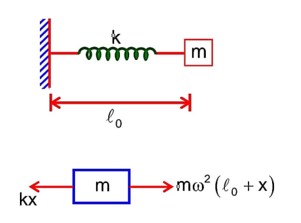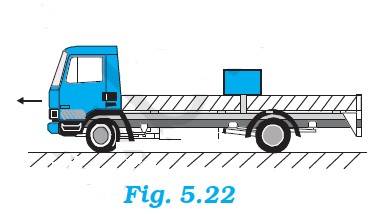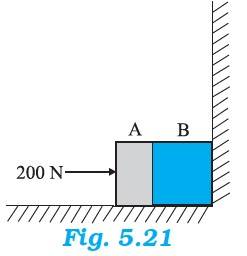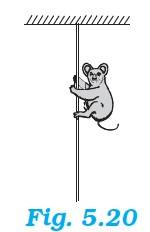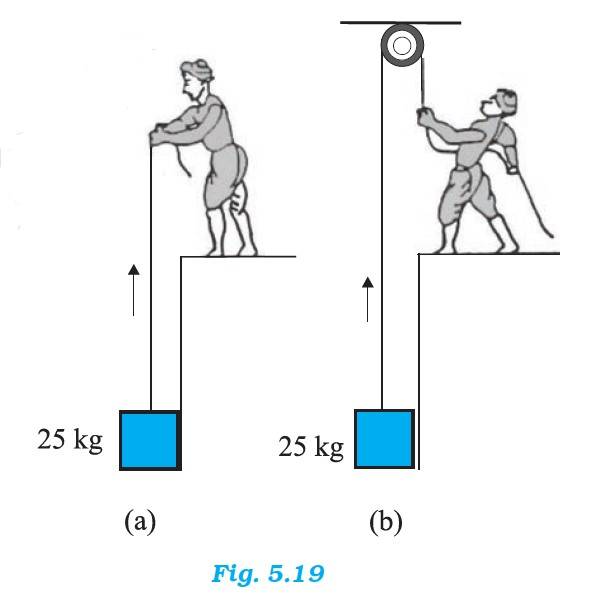Laws of Motion
Get insights from 109 questions on Laws of Motion, answered by students, alumni, and experts. You may also ask and answer any question you like about Laws of Motion
Follow Ask QuestionQuestions
Discussions
Active Users
Followers
New answer posted
6 months agoContributor-Level 10
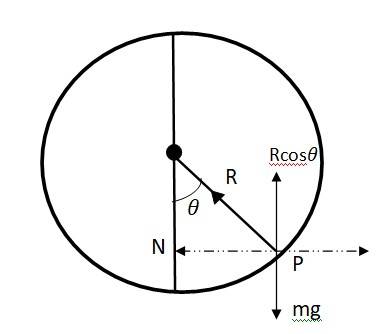
Let be the angle made by the radius vector joining the bead and the centre of the wire with the downward direction. Let, N be the normal reaction.
mg = N …….(1)
mr = N ……(2)
m(R ) = N
Hence N = m(R)
Substituting the value on N in eqn (1)
mg = mR
or = g/ R ………(3)
As 1, the bead will remain at the lowermost point
g/ R
For = becomes
= g/ R
=(g/R)(R/2g) = ½
New answer posted
6 months agoContributor-Level 10
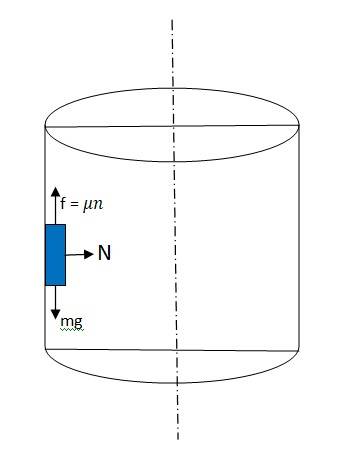
Mass of the man, m = 70 kg
Radius of the drum, r = 3 m
Coefficient of friction between the wall and his clothing, = 0.15
Number of revs of hollow cylindrical drum = 200 rev/min = 200/60 rev/s = 3.33 rev/s
The centripetal force required is provided by the normal N of the wall on the man
N = m = m R
When the floor revolves, the man sticks to the wall of the drum. Hence, the weight of the man (mg) acting downwards is balanced by the frictional force acting vertically upwards.
The man will not fall, if
mg
mg )
= 10/ (3 0.15)
New answer posted
6 months agoContributor-Level 10
When the motorcyclist is at the uppermost point of the death well, the normal reaction R on the motorcyclist by the ceiling of the chamber acts downwards. His weight mg also acts downwards. The outward centrifugal force acting on the motorcyclist is balanced by two forces.
R + mg = m , where v is the velocity and m is the combined mass of the motorcycle and motorcyclist
Because of the balance between the forces, the motorcyclist does not fall.
The minimum speed required at the uppermost position to perform a vertical loop is given by R = 0 in the above equation.
So mg = m or v = = = 15.8 m/s
New answer posted
6 months agoContributor-Level 10
Speed of revolution of the disc, n = rev/min = 100/3 rpm = 100/ (3
Angular acceleration = 2 = 2 = 3.492 rad/s
The coins revolve with the disc. The centripetal force is provided by the frictional force …. (1)
As v = r , the above equation becomes mr
r
r (0.15 = 12 cm
For coin A, r = 4 cm
The condition (r 12 ) is satisfied for the coin placed at r = 4 cm, so coin A will revolve with the disc.
The condition (r 12 ) is not satisfied for the coin placed at r = 14 cm, so coin B will not revolve with the disc.
New answer posted
6 months agoContributor-Level 10
Force on the box, F = MA = 40 2 N = 80 N
Frictional force, Ff = = 0.15 60 N
Net force = F – Ff = 80 – 60 = 20 N
From the equation F = ma, we get the backward acceleration produced in the box
a = 20/40 = 0.5 m/s2
From the equation s = ut + , to travel s = 5 m by the box to fall off from the truck, we get
5 = 0 + 0.5
5 = 0.25 , t = 4.47 s
The travel of truck during t = 4.47 s is
= 0 + 0.5 = 0.5 = 19.98 m
New answer posted
6 months agoContributor-Level 10
Mass of the block = 15 kg
Coefficient of static friction between the block and the trolley = 0.18
Acceleration of the trolley = 0.5 m/s2
(a) Force experienced by block, F = MA = 15 0.5 = 7.5 N. This fore acts in the direction of motion of the trolley
Force of friction, Ff = = 0.18 N = 27 N
Force experienced by the block is less than the friction, hence for a stationary observer on the ground, the block will be stationary
(b) When an observer moves with the trolley, the trolley will appear to be at rest
New answer posted
6 months agoContributor-Level 10
Mass of the body A, = 5 kg
Mass of the body B, = 10 kg
Applied force = 200 N
Coefficient of friction between the bodies and the table, μs = 0.15
(a) The frictional force is given by the relation
fs = ( + )g = 0.15 22.5 N. towards left
Hence, the force on the partition = 200 – 22.5 N = 177.5 N, acting rightwards
According to Newton's 3rd law, the reaction of the partition will be 177.5 N, acting towards left
(b) Force of friction on mass A is given by
Fa = mAg = 0.15 7.5 N, acting leftward
The net force exerted by mass A on mass B = 200 -7.5 N =
New answer posted
6 months agoContributor-Level 10
Mass of the monkey = 40 kg
Maximum tension of the rope Tmax = 600 N
(a) When the monkey climbs up with an acceleration of 6m / s2
Tension in the rope, T – mg = ma
T = m (g+a) = 40 (10+6)= 640 N
Since T > Tmax, the rope will break
(b) When the monkey climbs down with an acceleration of 4m/s2
Tension in the rope T is given by mg – T = ma
T = m (g-a) = 40 (10-4) N = 240 N
Since T < T max, the rope will not break
(c) Climbs up with an uniform speed of 5 m/s
In this case, the acceleration = 0
The tension in the rope is given by
T –mg = ma
T = mg = 40
Since T < Tmax, the rope will not break
(d) When the monkey falls down freely under gravity
The tension in the rope is given by the equat
New answer posted
6 months agoContributor-Level 10
Mass of the block = 25 kg
Mass of the man = 50 kg
Acceleration due to gravity = 10 m/s2
Weight of the block = 250 N
Weight of the man = 500 N
In the 1st case, the man lifts the block directly, applying an upward force, same as the block = 250 N
Due to Newton's 3rd law of motion, the downward reaction of the man on the floor = 500 N + 250 N = 750 N
In the 2nd case, the man applies a downward force of 25 kg wt. According to Newton's 3rd law, the action on the floor by the man 500N-250N = 250N
The man should adopt the second case
Taking an Exam? Selecting a College?
Get authentic answers from experts, students and alumni that you won't find anywhere else
Sign Up on ShikshaOn Shiksha, get access to
- 65k Colleges
- 1.2k Exams
- 679k Reviews
- 1800k Answers

